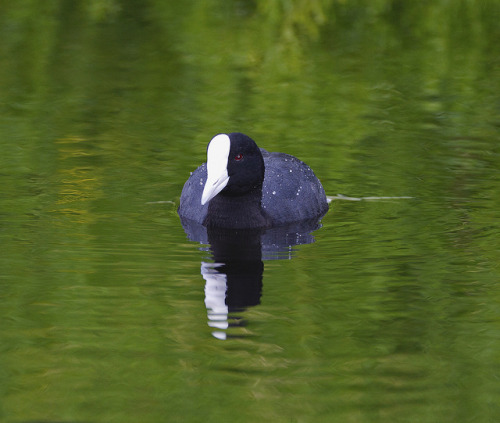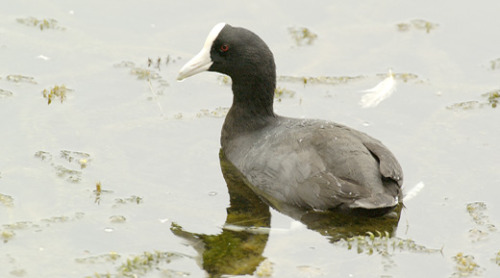Species Spotlight: Hawaiian Coot
Article by Elena Fischer, External Affairs Kupu AmeriCorps Intern with the U.S. Fish and Wildlife Service

An ‘alae ke’oke’o swims in water. Photo Credit: Dan Clark / USFWS
Scientific Name: Fulica alai
Hawaiian Name: ʻAlae keʻokeʻo / ‘Alae kea
Common Name: Hawaiian Coot
Status: Endangered
With a name that translates to white (kea) mudhen (‘alae), it is easy to imagine what these coots look like. However, the name may be misleading: it is not part of the hen family, but the rail family. Its geographic isolation on the main Hawaiian Islands has led to its uniqueness, separating itself from its mainland coot cousins. This isolation has also made it more precarious to extinction from habitat loss and predation. Since being on the Endangered Species List though, its croaking calls can be heard more frequently throughout the islands.

An ‘alae ke’oke’o swims in a reflective pool. Photo Credit: USFWS
Habitat and Range
ʻAlae keʻokeʻo are most common on the wetlands of O’ahu, Maui, and Kaua’i, but are found on all of the main Hawaiian islands except Kaho’olawe. These endangered native waterbirds prefer brackish and freshwater marshes and ponds. ʻAlae keʻokeʻo rarely fly, but they are able to sustain flight close to the water. They also are very territorial over nesting sites: they flap their wings to stay upright while kicking their feet, raise their tail feathers, and lower their head.
During breeding season (December to March) they prefer deeper water (18 inches deep) with emergent vegetation. The aquatic plants provide the vertical structure for nests and also provide cover for young birds.
Diet and Life Cycle
ʻAlae keʻokeʻo build floating nests on emergent vegetation in standing water, laying 3 to 10 eggs. Both parents help to raise the chicks, which hatch after 25 days. The young are precocial–they can run and swim soon after hatching–but still need care from the adults for several months. When born, chicks have black down except for their reddish-orange neck and head down. After fledging, both males and females will develop black feathers for the head, a slate gray body
with white undertail feathers, and a white frontal shield and bill.
‘Alae ke’oke’o are generalist feeders, often foraging in open water. They eat seeds and leaves of aquatic plants, insects, small invertebrates (snails and crustaceans), tadpoles, and small fish.

An adult ‘alae ke’oke’o holds food in its bill for two chicks, all swimming in water. Photo Credit: USFWS
Threats to the Species
Habitat loss remains a threat to the ‘alae ke’oke’o, as wetlands are being filled, dredged, contaminated by oil spills, or altered for agricultural and other reasons (see the ‘alae ‘ula blog for more threats). Introduced predators also pose a problem for habitat maintenance and predate upon ‘alae ke’oke’o. These include: feral dogs and cats, mongooses, rats, Cattle Egrets, bullfrogs, Barn Owls, and ‘auku‘u (black-crowned night herons). Invasive plants species also reduce water levels and necessary habitats for ‘alae ke’oke’o, like water hyacinth, mangrove, and pickleweed. Avian diseases like botulism also pose a concern.
Reason for Hope
Since the ‘alae ke’oke’o was listed on the Endangered Species List in 1970, its population numbers have increased across the state, thanks to inter-agency and organization collaboration on research and protection. These conservation actions include restoring wetland habitats, banning hunting, monitoring, and predator control.

An adult ‘alae ke’oke’o swims in open water. Photo Credit: USFWS
Where You Can See Them
Kakahai’a NWR
Keālia Pond NWR
James Campbell NWR
Pearl Harbor NWR
Hanalei NWR
Hulēʻia NWR












